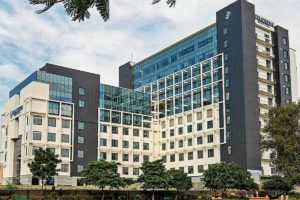Best Doctors in India for Neurofibromatosis Treatment
Best Hospitals in India for Neurofibromatosis Treatment
Reliance Hospital, Mumbai
- City: Mumbai, India
Hospital Highlights:
- Reliance Hospital is one of the best super-specialty care hospitals in Navi Mumbai.
- The main purpose of this hospital is to become a trustworthy place for the best health and hope for society. The hospital is well connected to the suburbs of Mumbai and Navi Mumbai.
- The hospital has various specialty departments, viz., Accident & Emergency, Anesthesiology, Dental Services, Dermatology, Diabetology, Dietetics Nutrition, Endocrinology, ENT, Gastroenterology, General Surgery, Gynaecology And Obstetrics, Hepato Pancreato Biliary Surgery, Infectious Disease, Internal Medicine, Interventional Radiology, Laboratory Medicine, Minimal Access Laparoscopic Surgery, Nephrology, Neurosciences, Opthalmology, Orthopaedics, Paediatrics, Pain Management Palliative Care, Physical Medicine Rehabilitation, Plastic And Reconstructive Surgery, Psychiatry, Pulmonary Medicine, Radiology, Rheumatology, Transplant, Urology Andrology, Vascular Surgery
Lilavati Hospital & Research Centre, Mumbai
- City: Mumbai, India
Hospital Highlights:
- Lilavati Hospital & Research Centre is India’s premier multi-speciality tertiary care hospital and has been recognised as a global medical excellence centre.
- Lilavati Hospital & Research Centre has built an unrivalled level of trust with its patients over the years, thanks to a solid foundation that comprises cutting-edge facilities, the best medical competence, research, education, and charity endeavours.
- The hospital is quite proud of the fact that it now serves patients from all kinds of backgrounds, not just from the United States but from all around the world.
- The hospital has a total of 323 beds, one of the largest Intensive Care Units (ICUs), 12 Operation Theatres with modern amenities, over 300 consultants, and almost 1,800 personnel.
Venkateshwar Hospital, Dwarka, New Delhi
- City: New Delhi, India
Hospital Highlights:
- State-of-the-art technology and devoted healthcare professionals have been brought together under one roof at Venkateshwar Hospital to provide genuine medical care. The hospital’s professionals work together as a team to deliver the best possible treatment to their patients, using the most sophisticated equipment and information technology.
- Venkateshwar Hospital’s mission is to attain global excellence in healthcare by employing evidence-based, ethical clinical practices and cutting-edge technology by a team of highly skilled experts.
MGM Healthcare, Chennai
- City: Chennai, India
Hospital Highlights:
- Located in Chennai, India, MGM Healthcare is a top multispecialty hospital that provides all medical services under one roof.
- Since its founding in 2019, MGM Healthcare has quickly become a leading national referral centre, creating several innovative flagship initiatives.
- MGM Healthcare combines next-generation medical and digital technologies to provide better patient results.
- With 12 centres of excellence, more than 400 inpatient beds, 100 intensive care unit beds, and 24/7 emergency care, MGM Healthcare leaves no chance in redefining the patient experience in Chennai.
- MGM Healthcare boasts 250+ expert doctors across 30+ departments, including Cardiology, Pulmonology, Neurology, Obstetrics & Gynaecology, and more.
- They house 12 specialized Centres of Excellence, including Neurosciences, Orthopaedics, and Multi-Organ Transplantation.
- Their team of doctors, nurses, and paramedics works together to give every patient individualized treatment.
Neurofibromatosis
Neurofibromatosis is an incurable genetic disorder that affects the entire nervous system. It can affect the development of nerve cell tissues. It also leads to tumors known as neurofibromas to develop on the nerves, which can lead to various other problems.
In some cases, they might be harmless but they might also cause serious damage if they compress the nerves as well as other tissues.
The disorder is of three types, i.e. Nf1, Nf2 and schwannomatosis, though they are not related.
Symptoms
The symptoms of neurofibromatosis can vary, depending on the type.
The disorder can spread throughout the whole body, causing tumors as well as unusual skin pigmentation. It can manifest as bumps as well, under the skin, colored sports, bone problems, pressure on spinal nerve roots, as well as other neurological problems.
In some cases, patients can also face learning disabilities, behavioral problems, or vision or hearing loss.
NF1 – When this type of neurofibromatosis affects an individual, he/she may show a skin condition but no other related medical problems. Birthmarks and freckles are common as well, among people with this condition. Freckles might appear at an unusual location, such as the groin, under the breasts, or in the armpits. People with this type of neurofibromatosis are also at a higher risk of hypertension or high blood pressure.
NF2 – NF2 is a more serious condition in which tumors grow on nerves deep inside the body. There might be several symptoms such as facial numbness, weakness, paralysis, hearing loss, loss of balance and vertigo, tinnitus, etc.
As the tumor grows, the symptoms might get worse. Tumors may also sometimes develop on the brain, skin, and spinal cord, with potentially serious consequences. Cataracts might also occur, as well as learning disabilities and behavioral problems. Tumor sometimes develops rapidly, but some grow slowly, and the effect might not be noticeable for several years.
Schwannomatosis – It is a rare form of neurofibromatosis, that generally affects less than 1 in 40,000 people. It is generally different from NF1 and NF2. This can cause pain, tingling, numbness, or weakness in the finger and toes.
Causes
The cause of neurofibromatosis is genetic defects or mutations that are either passed on by a parent or occur spontaneously during conception.
NF1- The NF1 gene is located on chromosome 17 and this gene produces a protein termed neurofibromin that helps regulate cell growth. The mutated gene causes a loss of neurofibromin, which allows cells to grow uncontrolled.
NF2- The NF2 gene is located on chromosome 22, and it produces a protein which is termed merlin, also called a schwannomin, which helps in suppressing tumors. The mutated gene can lead to a loss of merlin, lead which can cause uncontrolled cell growth.
Schwannomatosis- Two genes are generally known to cause schwannomatosis. Mutations of the genes SMARCB1 and LZTR1, which helps to suppress tumors, are associated with this type of neurofibromatosis.
Diagnosis
For NF1
Generally, NF1 is normally diagnosed during one’s childhood. A diagnosis is generally confirmed when an individual has at least two of the following:
- A family history of NF1
- Lesions in the bone
- A glioma, or tumor, on the optic nerve, which is mostly without symptoms
- At least six “café-au-lait” spots which measure over 5 millimeters across in children or 15 millimeters in adolescents or adults
- Freckling in the armpits, in the groin area, or under the breast
- At least two Lisch nodules, or small brown spots in the iris
- Two or more neurofibromas, or one “plexiform”
Plexiforms affect around 25 percent of people who have Nf1. Plexiforms are neurofibromas that spread around the large nerves as they grow, which leads to the nerve becoming thick and misshapen. They generally feel like knots or cords under the skin. They can be large as well as painful, and also disfiguring. Plexiform generally start forming during childhood.
A special type of lamp is used to check for any skin marks. Other diagnostic tools that your doctor can use include an X-ray, CT, or MRI scan. A genetic blood test might be required as well.
For NF2
Symptoms of NF2 generally appear around puberty or during adulthood. The most common age of onset is generally between 18 to 24 years.
Diagnosis of NF2 can be made when there is:
- An acoustic neuroma in one of the ears, along with two or more typical symptoms, such as cataracts, brain tumors, and a family history of the condition
- Acoustic neuroma along with brain or spinal tumors, which can be detected by an MRI or CT scan
- An acoustic neuroma in both the ears
- A faulty gene, which is identifiable through a blood test
A person having NF2 will be referred to a neurologist. Hearing and eye tests might also be conducted to check for cataracts, other eye problems, and hearing problems.
Treatment
Since there is no permanent cure for neurofibromatosis, treatments generally focus on the symptoms. Some of the symptoms generally do not need any treatment. Some of the options for treatment can include the following:
- Surgery for removing problem growths or tumors
- Treatment which can include chemotherapy or radiation if a tumor has turned malignant, or cancerous
- Surgery for bone problems, such as scoliosis
- Therapy which can include physical therapy or counseling
- Surgery for cataracts
- Auditory brainstem and cochlear implants
- Aggressive treatment of pain linked to the condition
- Stereotactic radiosurgery




